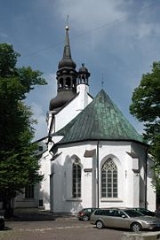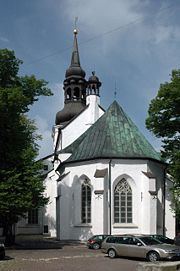
St Mary's cathedral of Tallinn
Encyclopedia

Toompea
Toompea is a limestone hill in the central part of the city of Tallinn, the capital of Estonia. The hill is an oblong tableland, which measures about 400 by 250 metres, has an area of and is about 20–30 metres higher than the surrounding areas...
in Tallinn
Tallinn
Tallinn is the capital and largest city of Estonia. It occupies an area of with a population of 414,940. It is situated on the northern coast of the country, on the banks of the Gulf of Finland, south of Helsinki, east of Stockholm and west of Saint Petersburg. Tallinn's Old Town is in the list...
, Estonia
Estonia
Estonia , officially the Republic of Estonia , is a state in the Baltic region of Northern Europe. It is bordered to the north by the Gulf of Finland, to the west by the Baltic Sea, to the south by Latvia , and to the east by Lake Peipsi and the Russian Federation . Across the Baltic Sea lies...
. Originally established by Danes on 13th century, it is the oldest church in Tallinn and mainland Estonia. It is also the only building in Toompea which survived a 17th century fire.
Originally a Roman Catholic
Roman Catholic Church
The Catholic Church, also known as the Roman Catholic Church, is the world's largest Christian church, with over a billion members. Led by the Pope, it defines its mission as spreading the gospel of Jesus Christ, administering the sacraments and exercising charity...
cathedral, it became Lutheran
Lutheranism
Lutheranism is a major branch of Western Christianity that identifies with the theology of Martin Luther, a German reformer. Luther's efforts to reform the theology and practice of the church launched the Protestant Reformation...
in 1561 and now belongs to the Estonian Evangelical Lutheran Church
Estonian Evangelical Lutheran Church
The Estonian Evangelical Lutheran Church is a Lutheran church in Estonia. EELC is member of the Lutheran World Federation...
.
__FORCETOC__
History
The first church was made of wood and built there most likely already in 1219 when the Danes invaded Tallinn. In 1229 when the Dominican monks arrived, they started building a stone church replacing the old wooden one. The monks were killed in a conflict between the Knights of the Sword and vassals supporting the Pope’s legate in 1233 and the church was contaminated. A letter asking permission to consecrate it anew was sent to Rome in 1233 and this is the first record of the church’s existence.The Dominicans couldn’t finish the building. Actually they built only the base walls. The building was completed in 1240 and it was a one-aisled building with a rectangular chancel. In 1240 it was also named cathedral and consecrated in honour of Virgin Mary. In the beginning of 14th century, reconstructions of the church began. The church was made bigger. The reconstructions began with building a new chancel. About at the same time the new vestry was built.
The enlargement of the one-aisled building to a three-aisled building began in the 1330s. The construction work however lasted almost 100 years. The new, longitudinal part of the church, 29 meters long, built by following the principles of basilica, was completed in the 1430s.
The nave’s rectangular pillars had been completed in the second half of the 14th century, though.
The church was greatly damaged in the great fire of 1684 when the entire wooden furnishing was destroyed. Some vaults collapsed and many stone-carved details were greatly damaged- especially in the chancel
Chancel
In church architecture, the chancel is the space around the altar in the sanctuary at the liturgical east end of a traditional Christian church building...
.
In 1686, after the fire, the church was practically restored to what it had been before. Pulpit
Pulpit
Pulpit is a speakers' stand in a church. In many Christian churches, there are two speakers' stands at the front of the church. Typically, the one on the left is called the pulpit...
with figures of the apostles (1686) and the altarpiece
Altarpiece
An altarpiece is a picture or relief representing a religious subject and suspended in a frame behind the altar of a church. The altarpiece is often made up of two or more separate panels created using a technique known as panel painting. It is then called a diptych, triptych or polyptych for two,...
(1696) were made by Estonian sculptor and carver Christian Ackermann
Christian Ackermann
Christian Ackermann was a sculptor and carver who worked in Estonia.-Life and work:Christian Ackermann was born in Königsberg. He worked in Riga, Stockholm, and Gdańsk, before becoming active in Tallinn from about 1672 until his death in 1710. In 1675, Ackermann moved to Tallinn and acquired his...
.
The Dome Church’s exterior dates from the 15th century, the spire dates from the 18th century. Most of the church’s furnishings goes back to the 17th and 18th centuries. From 1778 to 1779 a new baroque spire was built in the western part of the nave.
One should also mention a numerous sum of different kinds of tombstones from 13th –18th century, the stone-carved sarcophagi from the 17th century, also the altar and chancel, chandeliers, numerous coats-of arms from the 17th – 20th centuries. Two of the church’s four bells date back to 17th century, two date to the 18th century. The organ was made in 1914.
Among the people buried in the cathedral are the Bohemian nobleman Jindrich Matyas Thurn
Jindrich Matyas Thurn
Jindřich Matyáš Thurn-Valsassina , was a leading Bohemian nobleman, one of leaders against Ferdinand II of Bohemia and in events that led to the Thirty Years War, and in the end a...
, one of leaders of Protestant revolt against emperor Ferdinand II and in events that lead to the Thirty Years War, Swedish soldier Pontus De la Gardie
Pontus De la Gardie
Pontus De la Gardie was a French nobleman and general in the service of Denmark and Sweden.He was born Ponce De La Gardie in Russol , Languedoc, as a son of Jacques De la Gardie and Catherine de Sainte-Colombe. As a youngster, he wanted to become a priest and was educated in a monastery...
and his wife Sophia (John III
John III of Sweden
-Family:John married his first wife, Catherine Jagellonica of Poland , house of Jagiello, in Vilnius on 4 October 1562. In Sweden, she is known as Katarina Jagellonica. She was the sister of king Sigismund II Augustus of Poland...
's daughter), as well as the Scotsman Samuel Greig
Samuel Greig
Samuel Greig, or Samuil Karlovich Greig , as he was known in Russia - Scottish-born Russian admiral who distinguished himself in the Battle of Chesma and the Battle of Hogland...
(formerly Samuil Karlovich Greig of the Russian Navy) and the Russian navigator Adam Johann von Krusenstern
Adam Johann von Krusenstern
Adam Johann Ritter von Krusenstern , was an admiral and explorer, who led the first Russian circumnavigation of the globe.- Life :...
.
See also
- ToompeaToompeaToompea is a limestone hill in the central part of the city of Tallinn, the capital of Estonia. The hill is an oblong tableland, which measures about 400 by 250 metres, has an area of and is about 20–30 metres higher than the surrounding areas...
- TallinnTallinnTallinn is the capital and largest city of Estonia. It occupies an area of with a population of 414,940. It is situated on the northern coast of the country, on the banks of the Gulf of Finland, south of Helsinki, east of Stockholm and west of Saint Petersburg. Tallinn's Old Town is in the list...

